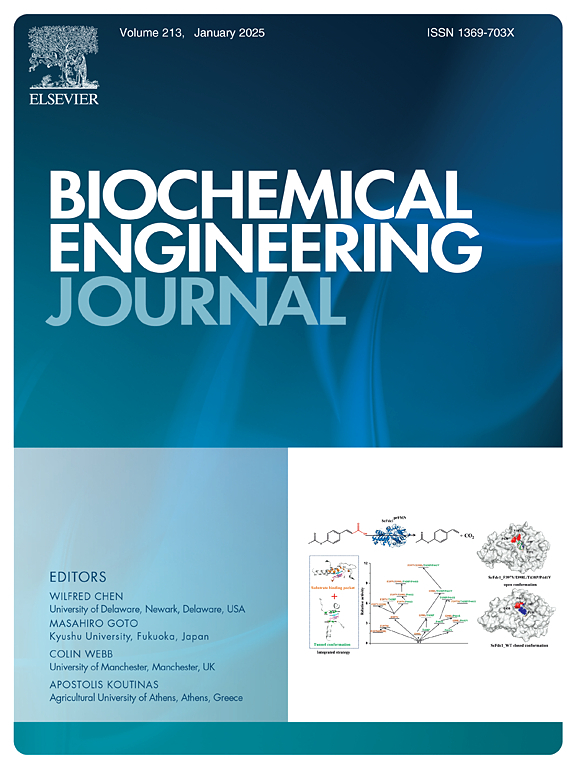Effectiveness of Musa balbisiana bract toward chromium removal from industrial tannery effluent: Optimization, kinetics, isotherms, regeneration, and cost estimation
IF 3.7
3区 生物学
Q2 BIOTECHNOLOGY & APPLIED MICROBIOLOGY
引用次数: 0
Abstract
Eradicating chromium from industrial effluent is essential for environmental security and economic reasons. This study investigates the potency of activated Musa balbisiana bract biomass as a biosorbent to remove hexavalent chromium (Cr6+) from real industrial tannery effluent (ITE). The characterization study exemplifies the existence of irregular structures and excessive cavities, and the occurrence of functional groups (hydroxyl, carboxyl, esters, and alkynes) are benefitting the deposition of Cr6+ on the biosorbent. A maximum biosorption capacity of 42.75 ± 0.21 mg/g was observed at an optimum pH of 6.5, biosorbent dosage of 0.3 g, initial Cr6+ concentration of 50 mg/L, and contact time of 120 min. The validation experiment confirmed the removal efficiency of total chromium, trivalent chromium, and Cr6+ 92.56 ± 0.80 %, 98.63 ± 0.20 %, and 96.21 ± 0.50 %, respectively. Among the models, Langmuir isotherm (R2: 0.9992) and pseudo-second order (R2: 0.9999) kinetic models greatly correlate with the equilibrium data. A 2-tier membrane module was examined for continuous study and reached 88.23 ± 0.60 % Cr6+ removal. Statistical analysis was performed to confirm the significance of adsorption results. The likelihood of the desorption and regeneration of the treated biosorbent was investigated. The estimated cost per volume of ITE treated and unit of pollutant removal from ITE employing Musa balbisiana bract biosorbent is around $3.08/m3 and $3.75/kg.
苞片麝香草从工业制革废水中去除铬的效果:优化、动力学、等温线、再生和成本估算
消除工业废水中的铬对环境安全和经济发展至关重要。本研究调查了活性苞片麝香草生物质作为生物吸附剂去除实际工业制革废水(ITE)中六价铬(Cr6+)的有效性。表征研究表明,不规则结构和过多空腔的存在以及官能团(羟基、羧基、酯和炔基)的出现有利于 Cr6+ 在生物吸附剂上的沉积。在最佳 pH 值为 6.5、生物吸附剂用量为 0.3 克、初始 Cr6+ 浓度为 50 毫克/升、接触时间为 120 分钟时,观察到最大生物吸附容量为 42.75 ± 0.21 毫克/克。验证实验证实,总铬、三价铬和 Cr6+ 的去除率分别为 92.56 ± 0.80 %、98.63 ± 0.20 % 和 96.21 ± 0.50 %。在这些模型中,Langmuir 等温线模型(R2:0.9992)和伪二阶动力学模型(R2:0.9999)与平衡数据有很大的相关性。对 2 层膜组件进行了连续研究,其对 Cr6+ 的去除率达到了 88.23 ± 0.60%。统计分析证实了吸附结果的重要性。研究了经处理的生物吸附剂解吸和再生的可能性。使用苞片麝香草生物吸附剂处理 ITE 的单位体积和去除 ITE 中污染物的单位成本估计分别约为 3.08 美元/立方米和 3.75 美元/千克。
本文章由计算机程序翻译,如有差异,请以英文原文为准。
求助全文
约1分钟内获得全文
求助全文
来源期刊

Biochemical Engineering Journal
工程技术-工程:化工
CiteScore
7.10
自引率
5.10%
发文量
380
审稿时长
34 days
期刊介绍:
The Biochemical Engineering Journal aims to promote progress in the crucial chemical engineering aspects of the development of biological processes associated with everything from raw materials preparation to product recovery relevant to industries as diverse as medical/healthcare, industrial biotechnology, and environmental biotechnology.
The Journal welcomes full length original research papers, short communications, and review papers* in the following research fields:
Biocatalysis (enzyme or microbial) and biotransformations, including immobilized biocatalyst preparation and kinetics
Biosensors and Biodevices including biofabrication and novel fuel cell development
Bioseparations including scale-up and protein refolding/renaturation
Environmental Bioengineering including bioconversion, bioremediation, and microbial fuel cells
Bioreactor Systems including characterization, optimization and scale-up
Bioresources and Biorefinery Engineering including biomass conversion, biofuels, bioenergy, and optimization
Industrial Biotechnology including specialty chemicals, platform chemicals and neutraceuticals
Biomaterials and Tissue Engineering including bioartificial organs, cell encapsulation, and controlled release
Cell Culture Engineering (plant, animal or insect cells) including viral vectors, monoclonal antibodies, recombinant proteins, vaccines, and secondary metabolites
Cell Therapies and Stem Cells including pluripotent, mesenchymal and hematopoietic stem cells; immunotherapies; tissue-specific differentiation; and cryopreservation
Metabolic Engineering, Systems and Synthetic Biology including OMICS, bioinformatics, in silico biology, and metabolic flux analysis
Protein Engineering including enzyme engineering and directed evolution.
 求助内容:
求助内容: 应助结果提醒方式:
应助结果提醒方式:


